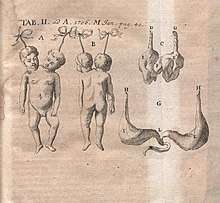Nicolaas Bidloo
Nicolaas Bidloo (c. 1673/74 in Amsterdam – 23 March 1735) was a Dutch physician who served as the personal physician of Tsar Peter I of Russia (Peter the Great). Bidloo was the director of the first hospital in Russia as well as the first medical school in Russia, and is considered one of the founders of Russian medicine.[1]
Nicolaas Bidloo | |
|---|---|
| Born | 1674 |
| Died | 14 April 1735 |
| Occupation | physician |
| Partner(s) | Clasina Claes |
| Parent(s) |
|
Early years
Bidloo came from a Mennonite family of scientific repute. His father Lambert Bidloo (1638–1724) was an apothecary and wrote a treatise on botany [2] and his uncle Govert Bidloo was the personal physician of King William III of England. In 1690 he confirmed his belief and became a member of the Mennonites in Amsterdam. Bidloo studied medicine at Leiden University, where his uncle Govert was a professor, and in January 1697 received a doctorate in the medical sciences. In 1701 the 27-year-old Nicolaas married Clasina Claes in Amsterdam.[3]
Personal physician of Peter the Great
In 1702, Bidloo signed a contract with the Russian ambassador to serve as Tsar Peter the Great's personal physician for a period of six years, at an annual salary of 2500 Dutch guilders (an extraordinarily high pay for a physician at that time). He arrived in Russia with his family in June 1703. As the tsar's personal physician, Bidloo accompanied Peter the Great on his travels, but found himself with very little to do, as the tsar was in excellent health.[3]

As part of this efforts to modernize Russia, Peter the Great in 1707 ordered the establishment of the country's first hospital and appointed Bidloo as its director. Peter the Great granted Bidloo a piece of land on the Yauza River, in the German Quarter on the outskirts of Moscow, to build the hospital as well as a house for himself and his family. As part of the hospital, Bidloo founded the first Russian medical school, where he gave instruction in anatomy[4] and surgery to 50 students. The hospital and medical school also contained Russia's first anatomical theater. Here, Peter the Great regularly attended dissections.[5] In 1710 Bidloo published the first Russian textbook on medical studies, a 1306-page manual of surgery entitled Instructio de chirurgia in theatro anatomico studiosis proposita a.d. 1710, januarii die 3.[1][3][6]
The hospital burned down in 1721 but was restored and reopened in 1727.[7] Bidloo died in St Petersburg. He was succeeded by Antonius Theils, and in 1742 by Herman Kaau Boerhaave, nephew of Herman Boerhaave.[8] His brother Abraham Kaau Boerhaave arrived in 1746 and was appointed in the Kunstkamera.[9]
Bidloo's gardens
Bidloo laid out extensive gardens on the hospital estate, including ponds, statues, a triumphal arch, and a botanical garden based on the Hortus Botanicus in Leiden. He also advised Peter the Great on horticulture, gardens and fountains. The tsar visited Bidloo's garden frequently, even when Bidloo was not at home. Supposedly, Bidloo was also one of the original designers of the Summer Garden and Peterhof in St. Petersburg. In 1730 Bidloo published a manuscript on his private garden, intended as a souvenir for his children. The manuscript included 19 drawings which Bidloo made of the gardens.[3][10][11] The manuscript is now in the collection of Leiden University.[12]
References
- Vein AA (December 2007). "[Nicolaas Bidloo, the Dutch director of the first hospital in Russia; a 300-year anniversary]". Nederlands Tijdschrift voor Geneeskunde (in Dutch and Flemish). 151 (52): 2909–12. PMID 18257439.CS1 maint: unrecognized language (link)
- "Bidloo, Lambert (1638–1724)", Global Anabaptist Mennonite Encyclopedia
- J. Dankmeijer and Th. Roell, "Nicolaas Bidloo and the Institution of Medical Education in Moscow" in Gerrit Arie Lindeboom (ed.), Boerhaave and his time: Papers read at the International Symposium in Commemoration of the Tercentenary of Boerhaave's Birth, Leiden, 15–16 November 1968, Volume 1968, Brill Archive, 1970, pp. 165–169
- Descriptio monstri humani bicipitis. Acta Eruditorum. Leipzig. 1706. p. 39.
- "De anatomische preparaten van Frederick Ruysch", University of Amsterdam & Peter the Great Museum of Anthropology and Ethnography, Russian Academy of Sciences
- Jozien J. Driessen-Van het Reve, De Kunstkamera van Peter de Grote: de Hollandse inbreng, gereconstrueerd uit brieven van Albert Seba en Johann Daniel Schumacher uit de jaren 1711–1752, Uitgeverij Verloren, Hilversum, 2006, p.222 (Dutch)
- G.A. Lindeboom, Geschiedenis van de medische wetenschap in Nederland. Fibula-Van Dishoeck, Haarlem 1981 (Dutch)
- L. Kooijmans (2014) De geest van Boerhaave. Onderzoek in een kil klimaat, p. 46, 57. Prometheus. Bert Bakker; A.J. Kox (ed.), Van Stevin tot Lorentz. Portretten van achttien Nederlandse natuurwetenschappers. Bert Bakker, Amsterdam 1990 (Dutch)
- L. Kooijmans (2014), p. 148.
- Christian Bertram, "Noord-Hollands Arcadia: Ruim 400 Noord-Hollandse buitenplaatsen in tekeningen, prenten en kaarten uit de Provinciale Atlas Noord-Holland". Stichting Provinciale Atlas Noord-Holland / Canaletto/Repro-Holland, Alphen aan den Rijn, pp. 13-14 (Dutch)
- Erik Jong, Nature and art: Dutch garden and landscape architecture, 1650–1740, University of Pennsylvania Press, 2000, p.10
- Peter Hayden, Russian Parks and Gardens, Frances Lincoln Ltd., 2005, pp. 53-54